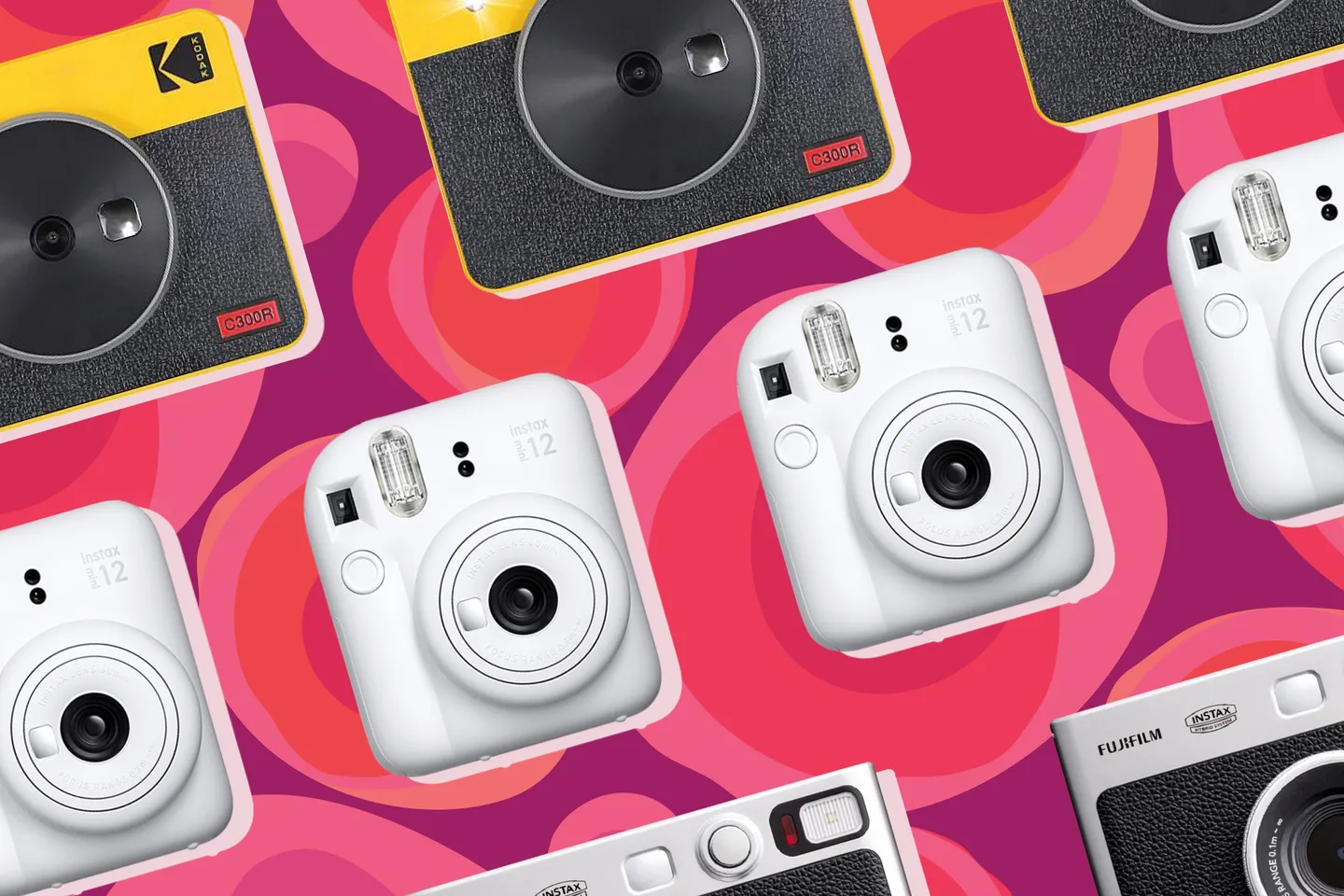Even if our phones allow us to take great pictures and share them right away with people worldwide, there’s still something special about the traditional instant camera. You can virtually instantly see and touch a photo that you have taken with just a single button press. Although instant camera photos aren’t as clear or flawless as those taken with contemporary digital cameras, their softness and flaws are frequently a major draw.
However, not every instant camera is created equal, and some are better suited for certain purposes and price ranges than others. For this reason, we put some of the most well-known instant cameras from companies like Kodak, Polaroid, and Fujifilm to the test.
If you’re looking for more creative control or features like filters, however, the Instax Mini Evo is our choice, one that boasts great image quality and allows you to choose which photos you’d like to print. Other instant cameras, like the second-gen Polaroid Now Plus and Kodak’s Mini Retro 3, also offer a variety of advanced creative modes for those who desire more.
Take a look at this list of our instant camera recommendations to find the best fit for you.
The best Instant Cameras
- Best instant camera for most people
- Best premium instant camera
- Best instant camera for social occasions
- Best instant camera for retro fans
- Best instant camera for portability
- A few more good instant cameras (and one to avoid)
Best Instant Camera for Most People

Fujifilm Instax Mini 12
For most people, the best instant camera is the Fujifilm Instax Mini 12. The basic instant camera has a built-in selfie mode, shoots quick and easy, high-quality pictures, and is devoid of more sophisticated functions. It’s available in a range of vibrant hues that kids and tweens would find particularly appealing.
Film type: Fujifilm Instax Mini film (sold separately) / Film size: 2 x 3-inches / Weight: 306 grams / Charging method: AA batteries / Companion app: None / Other features: Built-in selfie mirror, film counter.
We suggest Fujifilm’s Instax Mini 12 if all you want to do is press a button and receive a good print at a fair price. It’s a simple instant camera that bears some slight changes to our previous favorite, the Instax Mini 11. Shooting still takes less than five minutes, but setup is simpler because all you have to do is twist the lens to turn it “on” or “off.” Because of its simplicity of use and more compact design, the camera is especially suitable for children and beginners in photography.

The image quality of this instant camera is also superior than that of the majority of the other cameras I tried, yielding rather accurate photos. This camera, like the most of the ones I tried, had trouble taking good pictures in low light, but the built-in flash does help. I didn’t see much of a difference, but Fujifilm claims the Mini 12 optimizes image quality in both bright and dark conditions better than its predecessor. There are still times when the flash is too strong, leading to occasional overexposed photos. The flash cannot be turned off. The pictures appeared, if anything, a little duller and darker than before.
If nothing else, the Instax Mini 12 did a better job of capturing my skin tone and features when I utilized the built-in selfie function, which is essentially simply a tiny mirror on the front of the camera.

A redesigned lens structure that you may twist to access the Close-Up Mode rather than hitting a button has also made it slightly easier to zoom in. This mode allows you to use the new “Parallax Correction” feature on the camera, which should produce a more aligned image. Playing with the lens was enjoyable as it brought back memories of a classic point-and-shoot camera, but it takes some getting used to in order to create consistently good pictures. Even with the upgraded lens, centering your subject in the frame using this mode is still a little challenging, much like with the Mini 11. Fortunately, after a few tries and some composition, it becomes easy to align photographs correctly.
There are also extra luxuries that the Mini 12 delivers. The camera has a larger-than-average viewfinder, which I liked, and it has a small counter that shows how many pictures are left, something that many of the other instant cameras I tested did not have. It’s simple to lose count of the number of pictures you’ve taken, particularly when out for drinks or taking in the sights while on vacation. However, since each print costs roughly $1, you should be aware of how many pictures you still have.

Best premium Instant Camera

Fujifilm Instax Mini Evo
Fujifilm’s stylish Instax Mini Evo is the best premium instant camera. With it, you can choose which photos to print, while also boasting good image quality.
My coworker Becca Farcase and I both have a fondness for the Instax Mini Evo, one of Fujifilm’s newest instant cameras. Reminiscent of Fujifilm’s more costly X100 series of cameras, this hybrid camera is attractive to look at and has retro dials and buttons that are so fashionable that people stopped to talk to me as I was snapping pictures around Los Angeles.
Although its $199 price tag may make you cringe, if you use this camera frequently, its degree of adaptability may end up saving you money over time. This is because the Instax Mini Evo has a three-inch full-color LCD screen that allows you to preview and choose which photos to print, saving you film from being wasted on uninteresting shots. Due to the increased flexibility and lack of concern about running out of film, I was also able to experiment more creatively.
Film type: Fujifilm Instax Mini film (sold separately) / Film size: 2 x 3-inches / Weight: 285 grams / Charging method: USB-C (on newer models) / Companion app: Yes / Other features: LCD screen, smartphone printing.
In contrast to Fujifilm’s Instax Mini 12, the Mini Evo has a few additional capabilities that can improve your photo-taking abilities. For instance, the Mini Evo’s three-inch LCD screen can be used as a viewfinder while the flash is turned off. Additionally, you can use the menu to change the film’s brightness when it is printed out, which is useful because neither the Evo nor the Mini 12 are very good at capturing dark settings.
You can also utilize the dials to apply several lens settings and filters, such as a mirror lens, vignette, soft focus, and hues ranging from retro to monochromatic. Additionally, you may capture remote photos using an app, which adds another level of photography control that can surpass the quality of the selfie mirror in front for your self-portraits.

Best Instant Camera for Social Occasions

Kodak Mini Shot 3 Retro
Kodak’s hybrid Mini Shot 3 Retro instant camera comes with a fun companion app you can use to add frames, stickers, filters, conceal blemishes, and more. As long as you don’t mind the so-so image quality, this is a good digital instant camera for parties.
Film type: Kodak Instant Print 3 x 3-inch cartridge (included) / Film size: 3 x 3-inch square prints / Weight: 467 grams / Charging method: Micro USB / Companion app: Yes / Other features: LCD screen, smartphone printing.
Kodak’s hybrid Mini Shot 3 Retro is all about fun, but the accompanying software for the Instax Mini Evo is more useful. The camera is ideal for scrapbooking because of the accompanying smartphone app, which lets you add frames, stickers, filters, and a ton of other customization choices to photographs. This entertaining fast camera can be used as a kind of little picture booth at parties because it has a beauty feature that hides imperfections and a variety of Snapchat-like effects that you can apply, including dog ears.

Similar to the Instax Mini Evo, the Kodak Mini Shot 3 Retro has an LCD screen that you can use to choose whether or not to print a picture. It’s just lot smaller than the Instax Mini Evo’s. It also has Bluetooth, so you can print excellent, somewhat crisp photographs from your smartphone or post photos to social media using the Kodak Photo Printer app. In contrast to the Mini Evo, Kodak’s Mini Shot 3 Retro costs approximately $150 at retail and comes with a film pack (though it’s sometimes available for much less).
Best Instant Camera for Retro fans

Polaroid Now Plus (second-gen)
For those who love nostalgic, the Polaroid Now Plus 2nd generation is a fantastic instant camera that produces images in the way of the past while providing modern features like USB-C. It’s also a good option for artistic photography because it has a range of creative options.
Film type: Polaroid i-Type Color Film (sold separately) / Film size: 4.2 x 3.5-inch prints / Weight: 451.5 grams / Charging method: USB-C / Companion app: Yes / Other features: Lens filter kit, film counter.
The Polaroid Now Plus, which is in its second generation, is the ideal camera if you want to experience instant film in an authentic manner. With its timeless, retro-inspired design, it most closely resembles old instant cameras like the Polaroid 600 when compared to the other instant cameras on this list. In the meantime, images appear more authentically retro thanks to its square I-Type film prints and recognizable Polaroid-style frame.

Best Instant Camera for Portability

Polaroid Go
The Polaroid Go is the smallest and most affordable Polaroid instant camera on the market.
Film type: Polaroid i-Type Color Film (sold separately) / Film size: 2.6 x 2.1-inch prints / Weight: 242 grams / Charging method: Micro USB / Companion app: Yes / Other features: Selfie mirror, film counter.
The Polaroid Go is little, whereas the Polaroid Now Plus is enormous. It was so cute when I held it for the first time. Considering that I’m small and just over five feet tall, it easily fits into the palm of my hand. This instant camera is by far the most portable on our list; in fact, it’s so tiny that there were moments when I forgot I had it in my handbag. Of all the instant cameras I tried, it even creates the smallest prints, which can be useful if you’re looking to reduce space and want something even smaller than Instax Mini prints.

Moreover, the Polaroid Go is among the least expensive Polaroid cameras available right now, with film priced only little higher than Fujifilm’s Instax Mini images (or roughly $19.99 for a double pack of 16 sheets). Thankfully, image quality isn’t sacrificed for the affordable cost. Like most of the cameras on our list, the Go has trouble capturing low light conditions, but not as much as the Polaroid Now Plus. I wasted less film because, surprisingly, taking crisper pictures indoors was easier. Although the contrast and color saturation are still poor, the images that the Now Plus produces still have that old-fashioned, almost dreamlike quality to them.

Though double-pressing the flash button yields double-exposure images, the Go lacks creative settings and more sophisticated capabilities than the Polaroid Now Plus. Thankfully, it is rechargeable and comes with a Micro USB charging cord, but it does not support Bluetooth, so there is no fancy software to add further effects. Furthermore, as previously noted, the prints are even smaller than the Instax Mini, which may be a turnoff for individuals who favor more conventional, larger Polaroid images. Although it creates images with a comparable vintage feel, its design is nothing like that of classic Polaroid cameras, which may detract from the nostalgic feeling that some people are hoping for.
Nevertheless, there was no app available for any of the earlier Polaroid cameras. Overall, those looking for a camera that offers a more conventional instant film experience that they can use almost anyplace will find the Go to be a good option due to its simplicity.
The back of the Polaroid Go. Image



